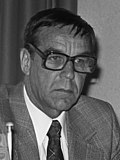| | First party | Second party | Third party |
|---|
| |  |  |  | | Leader | Rafael Paasio | Johannes Virolainen | Kusti Kulo |
|---|
| Party | SDP | Centre | SKDL |
|---|
| Last election | 19.50%, 38 seats | 22.95%, 53 seats | 22.02%, 47 seats |
|---|
| Seats won | 55 | 49 | 41 |
|---|
| Seat change |  17 17 |  4 4 |  6 6 |
|---|
| Popular vote | 645,339 | 503,047 | 502,374 |
|---|
| Percentage | 27.23% | 21.23% | 21.20% |
|---|
| Swing |  7.73pp 7.73pp |  1.72pp 1.72pp |  0.82pp 0.82pp |
|---|
| | | Fourth party | Fifth party | Sixth party |
|---|
| |  |  |  | | Leader | Juha Rihtniemi | Lars Erik Taxell | Mikko Juva |
|---|
| Party | National Coalition | RKP | Liberal People's |
|---|
| Last election | 15.06%, 32 seats | 6.11%, 13 seats | 6.86%, 14 seats |
|---|
| Seats won | 26 | 11 | 9 |
|---|
| Seat change |  6 6 |  2 2 |  5 5 |
|---|
| Popular vote | 326,928 | 134,831 | 153,259 |
|---|
| Percentage | 13.79% | 5.69% | 6.47% |
|---|
| Swing |  1.27pp 1.27pp |  0.42pp 0.42pp |  0.39p 0.39p |
|---|
| | | Seventh party | Eighth party | Ninth party |
|---|
| |  |  | | | Leader | Aarre Simonen | Veikko Vennamo | |
|---|
| Party | TPSL | Smallholders' Party | ÅS |
|---|
| Last election | 4.36%, 2 seats | 2.16%, 0 seats | 0.32%, 1 seat |
|---|
| Seats won | 7 | 1 | 1 |
|---|
| Seat change |  5 5 |  1 1 |  |
|---|
| Popular vote | 61,274 | 24,351 | 7,118 |
|---|
| Percentage | 2.59% | 1.03% | 0.30% |
|---|
| Swing |  1.77pp 1.77pp |  1.13pp 1.13pp |  0.02pp 0.02pp |
|---|
|










